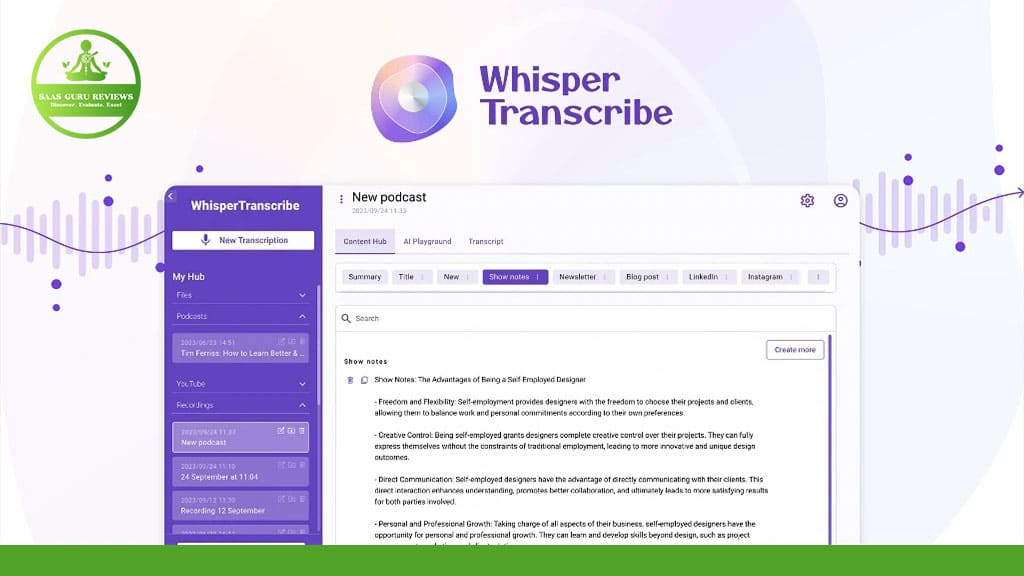In the ever-evolving world of technology, the ability to transcribe audio to text efficiently has become a game-changer for content creators, journalists, and businesses alike. OpenAI’s Whisper AI stands at the forefront of this revolution, offering a state-of-the-art solution for those looking to turn their audio into written content quickly and accurately. This article dives into the capabilities of Whisper AI, exploring how it can transform your audio files into high-quality transcripts, and why it’s worth considering for your transcription needs.
Article Outline:
1. What Is OpenAI’s Whisper?
2. How to Download and Run Whisper?
3. What Makes Whisper’s Transcription Quality Stand Out?
4. Can Whisper Transcribe Non-English Audio?
5. How Does Whisper Handle Multilingual Transcription?
6. Using Whisper to Generate Content for Social Media and More
7. Whisper and Accessibility: Helping Listeners Who Like to Read
8. Ratings and Reviews: What Are Users Saying About Whisper?
9. How to Get an Accurate Transcript with Whisper?
10. The Future of Transcription: What’s Next for Whisper AI?
1. What Is OpenAI’s Whisper?
OpenAI’s Whisper is an advanced speech recognition and transcription tool that leverages robust speech-to-text technology to convert audio into content. It’s designed to provide users with high-quality transcripts of their audio or video files, making it easier to generate written content from spoken language. Whisper AI’s capabilities extend beyond simple transcription, offering features such as language identification, punctuation inference, and support for multiple languages.
2. How to Download and Run Whisper?
To start using Whisper, you can download the model from GitHub, where OpenAI has made it available for public use. Running Whisper is straightforward for those familiar with command-line tools, and detailed instructions are provided to ensure a smooth setup process. Once installed, you can run Whisper on audio files to generate transcripts in various formats, such as SRT or VTT, which are useful for creating subtitles with timestamps.
3. What Makes Whisper’s Transcription Quality Stand Out?
Whisper’s transcription quality is often described as state-of-the-art, thanks to the AI model being trained on a large and diverse dataset. This training allows Whisper to accurately transcribe audio content, capturing nuances in speech and providing precise punctuation. The resulting text is not only accurate but also easy to read, making it an excellent tool for content generation and accessibility.
4. Can Whisper Transcribe Non-English Audio?
One of the standout features of Whisper is its ability to transcribe non-English audio files. Whisper was trained with a wide variety of languages, making it a multilingual tool that can handle languages such as Spanish, Mandarin, Hindi, and many more. This opens up opportunities for users who work with international content or need to transcribe audio in languages other than English.
5. How Does Whisper Handle Multilingual Transcription?
Whisper’s multilingual transcription capabilities are a testament to its advanced technology. The model can identify the language being spoken in an audio file and transcribe it accordingly. This is particularly useful for audio that contains multiple languages, as Whisper can seamlessly switch between them to provide an accurate transcript.
6. Using Whisper to Generate Content for Social Media and More
Whisper is not just a transcription tool; it’s also a powerful ally for content creators looking to generate custom content from audio. Whether you’re looking to create social media posts, blog articles, or other forms of written content, Whisper can help you convert spoken words into text that can then be edited and shared across various platforms.
7. Whisper and Accessibility: Helping Listeners Who Like to Read
Accessibility is a crucial aspect of content creation, and Whisper contributes significantly to this by providing transcripts for audio content. This is especially beneficial for listeners who prefer or require written content, such as those with hearing impairments or those who learn better through reading.
8. Ratings and Reviews: What Are Users Saying About Whisper?
When considering any app or tool, it’s essential to compare customer ratings and read reviews to gauge its effectiveness. Whisper has received positive feedback from users who appreciate its accuracy and ease of use. By looking at the ratings and reviews on platforms like the App Store and GitHub, potential users can get a sense of how Whisper might meet their transcription needs.
9. How to Get an Accurate Transcript with Whisper?
To get an accurate transcript using Whisper, users should ensure that the input audio is of good quality and that the correct language is specified if it’s non-English. Whisper’s advanced speech recognition will then process the audio, providing a transcript that closely matches the spoken content. Users can also adjust settings to improve the transcription quality further.
10. The Future of Transcription: What’s Next for Whisper AI?
As technology continues to advance, the future of transcription looks promising with tools like Whisper AI leading the charge. OpenAI is likely to continue improving Whisper, adding more languages and refining its capabilities to provide even more accurate transcriptions. The potential for integration with other platforms and applications also suggests that Whisper will become an increasingly valuable tool for a wide range of users.
Summary of Key Points:
- OpenAI’s Whisper AI is a cutting-edge transcription tool that turns audio into high-quality text content.
– Whisper can be downloaded from GitHub and run on various platforms to transcribe audio or video files.
– Its state-of-the-art transcription quality is due to being trained on a large dataset, allowing for accurate speech recognition and punctuation.
– Whisper supports multilingual transcription, capable of handling non-English audio and identifying multiple languages within a single file.
– The tool is invaluable for generating written content for social media, blogs, and other platforms from audio content.
– Whisper enhances accessibility by providing transcripts for those who prefer or require written content.
– User ratings and reviews on the App Store and GitHub indicate a positive reception for Whisper’s capabilities.
– To achieve the most accurate transcript, users should provide clear audio and specify the language if it’s non-English.
– The future of Whisper AI looks bright, with potential improvements and wider application use on the horizon.
In conclusion, OpenAI’s Whisper is a robust speech-to-text AI transcription tool that can transform audio and video files into text with impressive accuracy. The Whisper model is designed to understand and transcribe a diverse array of languages, including Azerbaijani, Catalan, Estonian, Galician, and many more, catering to a global user base. Users looking to convert speech from languages such as Kazakh, Marathi, Armenian, and Belarusian, among others, can rely on Whisper for quality transcription. This cutting-edge technology not only supports widely-spoken languages like Spanish and Mandarin but also provides support for less commonly catered languages such as Welsh and Maori, demonstrating its extensive reach. Whether you need to transcribe interviews in Croatian, lectures in Kannada, or meetings in Latvian, Whisper’s AI transcription service stands ready to convert your audio files into text efficiently. To learn more about Whisper or to download the model and start creating custom content from your audio, users can access OpenAI’s resources, ensuring that language barriers are minimized in the quest for accessible information. Whisper’s capability to process a wide range of tokens and its adaptability in handling different dialects and accents makes it an invaluable tool for anyone needing audio transcription, from professionals to language enthusiasts.



